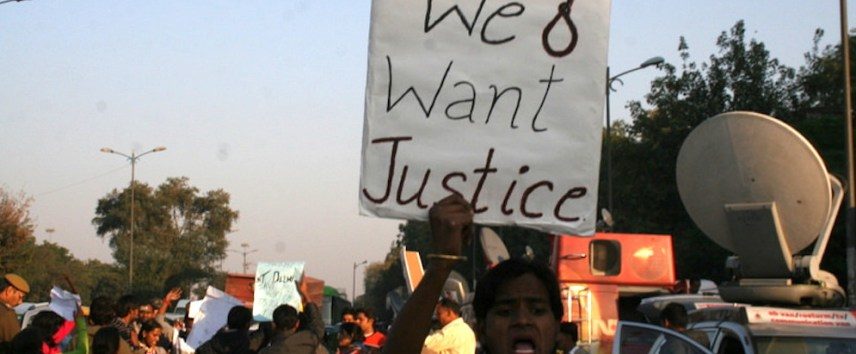
In response to public outrage against a spate of reported rapes of children, the government has now brought in an ordinance that imposes death to anyone convicted of raping a girl below 11. Why I think this ordinance won’t work, and what I think will.
The remarkable fact about recent Indian law-making, particularly when it comes to crimes against women, is that it seems to be based entirely on public emotion.
Public anger against the gang-rape of a physiotherapy student in December 2012 led to tough new amendments to the law against sexual violence.
It was public anger again – media folklore had it that the juvenile rapist in that crime was the ‘most violent’ — that led to the lowering of the age of delinquency from 18 to 16. What if the rapist is aged 14, asked one MP, Anu Agha. Notwithstanding that objection, Parliament voted to reduce the age in line with public opinion.
On Saturday, India’s cabinet met to clear an ordinance that will result in a death sentence to anyone convicted of raping a minor girl below the age of 11. On Sunday morning, India’s President signed off on it.
The ordinance comes on the heels of heightened public revulsion at a series of grisly rapes of little girls – one as young as a four-month-old baby — being reported ever since news broke of the gang-rape, torture and eventual murder of an eight-year-old child in Kathua, Jammu and Kashmir.
Nearly 40% of rape victims in India are below the age of 17, according to government data for 2016. One in 10 reported rapes was that of a child below the age of 12.
In 2016, 100 crimes against children were reported under a special law that protects them from sexual offences.
Everyone agrees that the problem is egregious. But no one seems to have a solution.
Every protest brings out the ‘death to rapists’ banners, and the new ordinance has brought in death for rape girls under the age of 11. But the existing law already has provisions for death sentencing.
That’s not the only reason why the new ordinance is troubling.
First, it is simply not been debated widely enough. It does not take into account the views of a cross-section of society, including child rights and women’s activists.
Second, there is no evidence that the death sentence has been a deterrent to any crime, not even murder.
Third, if you have the same punishment for rape as you do for murder, if the punishment does not get worse for the added offence of murder, then rapists might be tempted to kill victims rather than leave eyewitnesses.
Fourth, government data tells us that over 94% of all crimes against children are committed by men known to their victims, including close relatives. Bringing in an automatic death sentence for the rapist of a child who might be an uncle, a brother or a father, will result in a reluctance to report the crime and push it further underground
One obvious solution would be to push for swifter and greater convictions. The conviction rate for crimes against children is as low as 18%. Fast track courts set up to speed up trials exist only at the trial court stage. We need to fill judicial vacancies at all levels of the judiciary.
But it’s not just judicial reform. We also need police reform. A December 2017 report by Human Rights Watch talks of barriers to victims in accessing justice, despite a strict law. This begins right from the time she approaches the police station to register a complaint where police are often loathe to take down statements or then pressure victims to ‘settle’ or drop charges, said the report.
There are clearly laid down procedures for the medical examination of a rape victim. But doctors routinely use the outdated and banned ‘two-finger test’ to see if a victim is ‘habituated to sex’ that makes her fight for justice all the more difficult.
Prime Minister Narendra Modi’s first Independence Day address in 2014 asked parents to ‘put the same restrictions on their sons as they put on their daughters’. His flagship, Beti Bachao, Beti Padhao scheme was designed to set right India’s abysmal sex ratio. And for the first time in its history, we have a woman defence minister.
But to be considered truly reformist Modi needs to move beyond the optics.
There is urgent need to discuss not just retributive action, but preventive measures, and almost nobody is talking about what these might be in the five and a half years since 2012.
Sex education, for instance, has been resisted by successive, squeamish governments but is a crucial key to teaching boys and girls the concept of consent.
Instead of enthusiastically rewriting history textbooks, it might be more useful to include a more gender-sensitive curriculum where men and women are not slotted into gender roles that either demean women or promote toxic male masculinity.
Women need to be seen as citizens deserving of equal dignity, not just as ‘India’s daughters’. If we are to tackle rape culture, we need also to understand why 19.6 million women fell off the labour map, how to bring them back, how to keep them there and how economic empowerment is the first step to equality.
The Justice Verma Commission’s recommendations were broad and progressive. Now we need to set up a national task force, a Task Force to Eliminate Gender Disparity that draws from teachers, parents, civil rights, child rights and women’s rights activists, economists, judges, bureaucrats, anyone with a vision, anyone with a plan.
Social change is not an abstract idea. Stamping out rape and rape culture should not be impossible. But first, we must find the will.